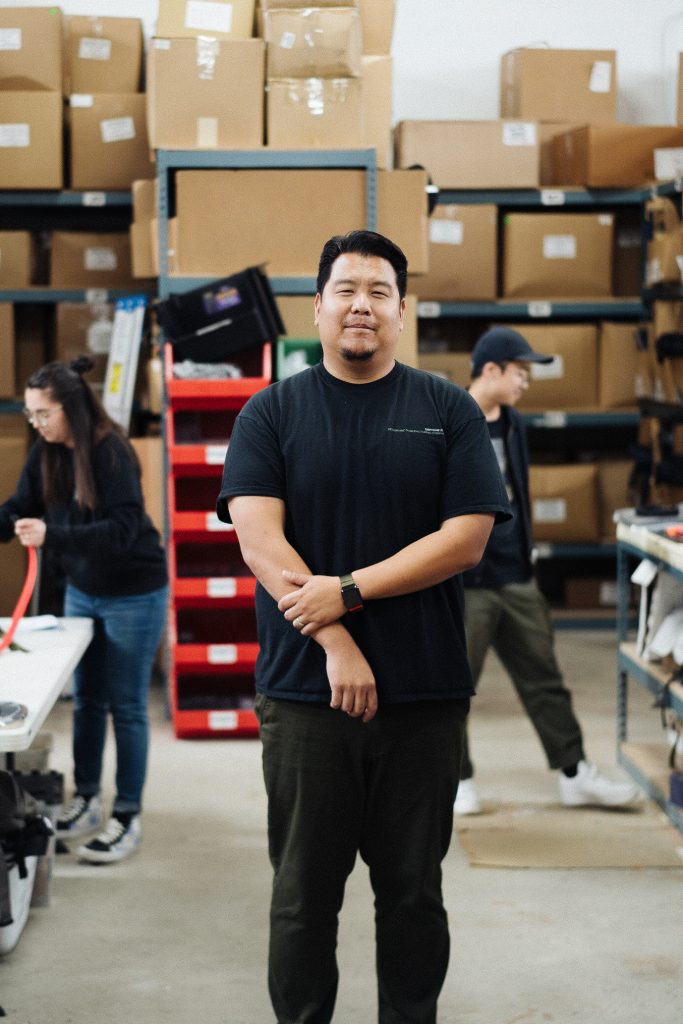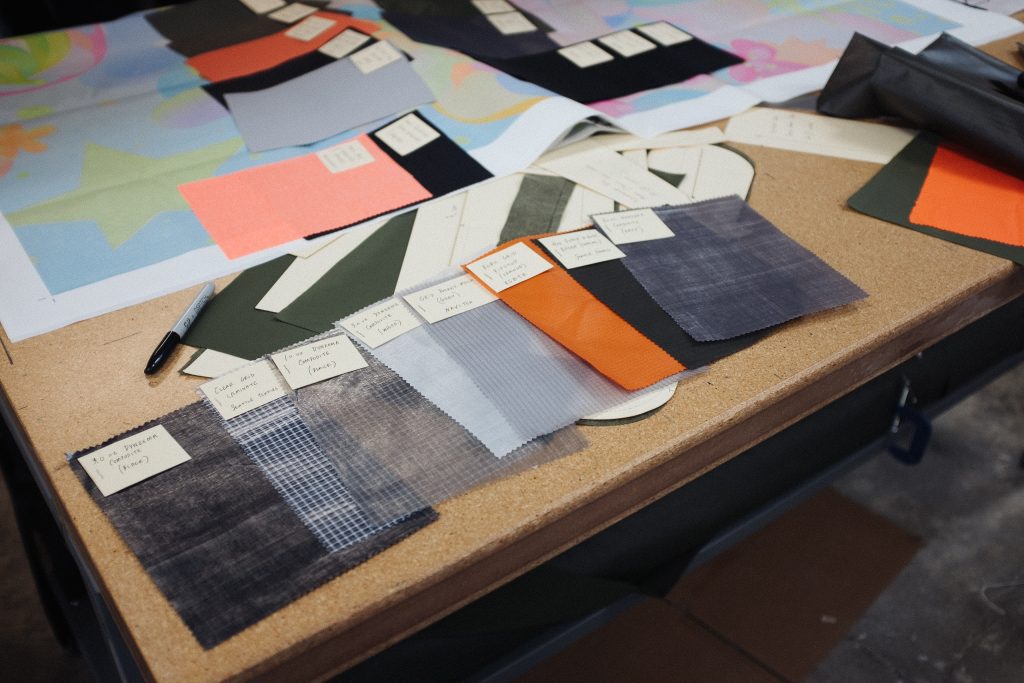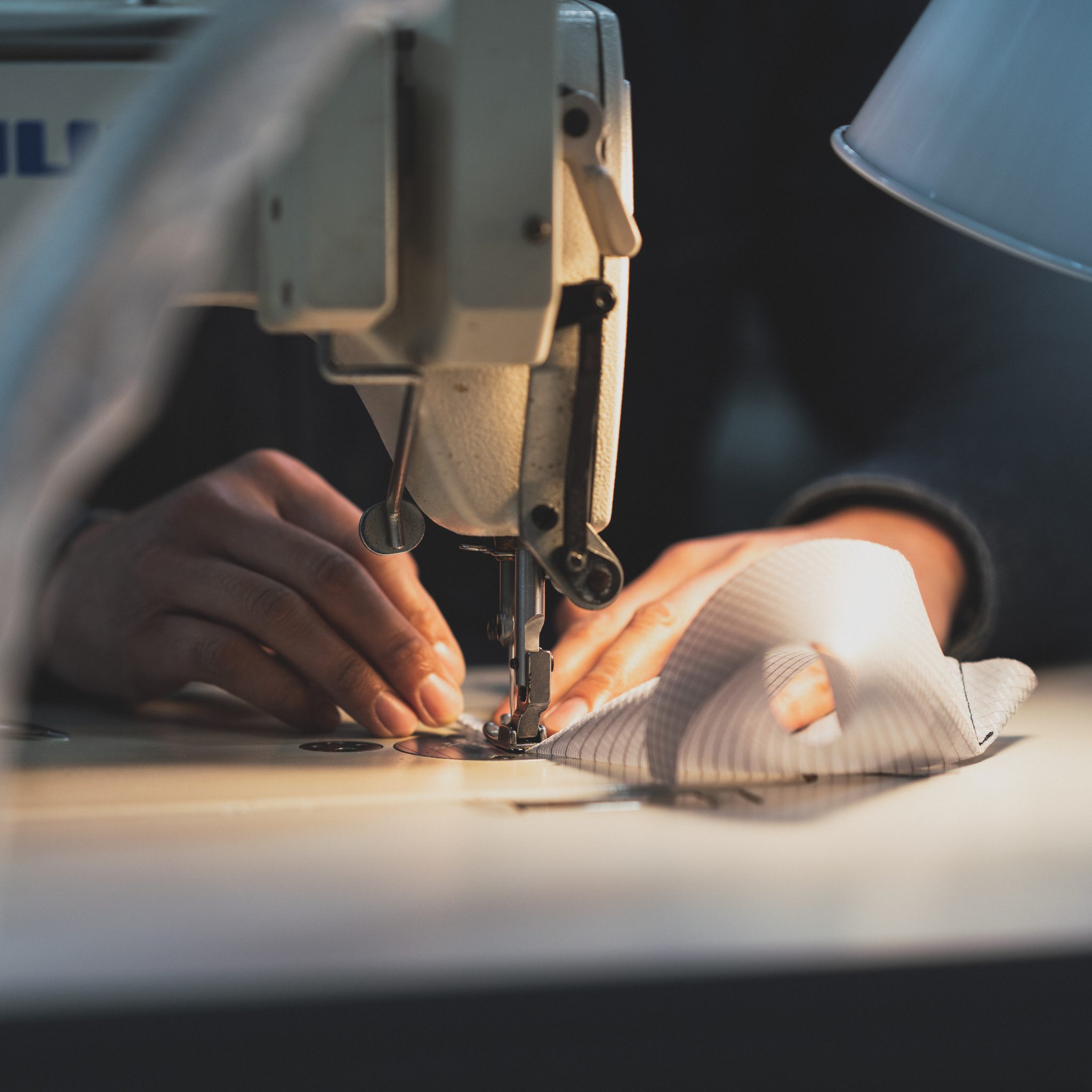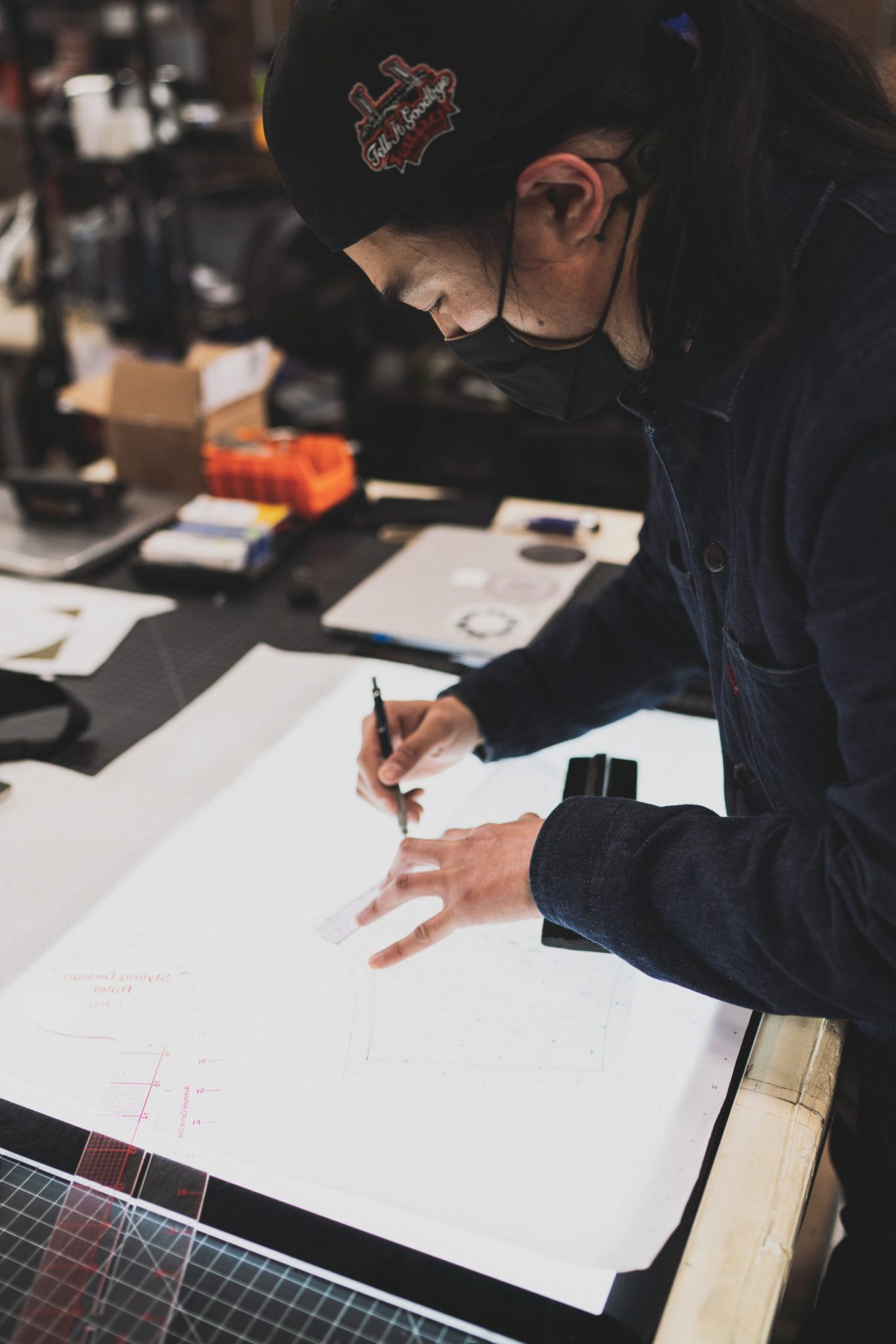Indestructible:
The DSPTCH Origin Story
With Richard Liu
Interview & Audio by Eugene Kan
Photos by Behzod Sirjani & Eugene Kan
For the MAEKAN and DSPTCH family, we’ve watched each other grow with great interest. Both of us share a similar perspective on creating and putting things out into the world. So when we first decided to explore creating product, DSPTCH was a natural first partner. Their flexible in-house manufacturing meant lower minimums and utilitarian design philosophy vibed with our perspective on what we wished to put out into an already crowded world.
The timeline for this project took far longer than anticipated, yet the conversation that supported this project and the underlying premise behind how we collectively run our companies are unchanged.
We’re excited to both share this thoughtful conversation and the release of our MAEKAN x DSPTCH “Done Slow, Done Right” Totebag.
At MAEKAN, the story defines the medium. Some stories function best as written text, others hope to capture the emotion through an intimate audio experience. In cases such as this audio story, the transcripts we provide are done to the best of our ability through AI transcription services and human transcribers. We try our best, but this may contain small errors or non-traditional sentence structure. The imperfection of humans is what makes us perfect.
Eugene Kan: Let’s set the scene. It’s the middle of 2021, and COVID is still a constant thought that dictates how we live our lives. Looking further outward into the distance, the world of business and entrepreneurship is in the middle of a shakeup. We’re closing our chapter of company building and brand building that was defined by an abundance of cheap money. The goal in this concluding chapter? To build businesses of massive scale. Behind us are the tombstones of many tech and consumer brands who leveraged an abundance of capital to create big, shiny facades with little foundation behind them, and once the money ran out, it all came crashing down.
For Rich Liu of industrial design bag and accessories brand DSPTCH, his way of building a business was the antithesis of what surrounded him in the Bay area. Instead, he took a more calculated and undeniably slower approach to building a brand that celebrates over a decade in business. Their bags, accessories, and experimental designs have captured the imagination and audiences around the world. For Rich and DSPTCH, their story closely mirrors the MAEKAN story.
It’s a sense of experimentation meets a desire to do things right— even if it takes a bit longer.

Rich at his workshop and warehouse in San Francisco.
Rich Liu: My name is Richard Liu. I started and run a company called DSPTCH. We make military inspired bags and accessories. Everything’s mostly made here in the United States. Our headquarters is currently in South San Francisco.
Eugene Kan: Take it back to your life before DSPTCH. What did that look like growing up and how did that sort of evolve into what you do now? I’ve known Richard for a long time and I’ve always been very interested in his background because, in many ways, it crisscrosses. It’s not this very clean trajectory.
Rich Liu: I would say one thing that I value highly — I don’t know if it’s much of a take away — but I had a love for art as a child. I painted a lot and spent my summers in painting class or art camps exploring sculpture or whatever, things like that where they let you try everything. I’m American born Chinese and I have immigrant parents that pretty much fall into almost all the stereotypes you would expect from that.
So when I got to high school, they said, “you gotta be practical.” I remember this exact conversation. I was like, “oh, I want to be an architect because I thought art, design. It’s a job I can go do.” And I remember my dad saying, “there’s no money there. You’re going to be struggling. You’re going to be a poor artist. That’s just a bad decision.” And as a twelve-year-old, you just internalize that. So in high school and in college, I was just doing business. It was like, “I gotta make a living. I have to make money.” That’s all I thought about.
“I remember my dad saying, ‘there’s no money there. You’re going to be struggling. You’re going to be a poor artist. That’s just a bad decision.’ And as a twelve-year-old, you just internalize that.
So in high school and in college, I was just doing business. It was like, ‘I gotta make a living. I have to make money.’ That’s all I thought about.”
— Richard Liu, founder of DSPTCH
Eugene Kan: Curious, what are your thoughts on the way financial stability, and financial positioning plays in one’s ability to pursue creative passions? I think what you mentioned is a very familiar story: if you are an immigrant, then they generally default into stability, but what happens when you have stability? Do you feel like, now that you have a family, that their trajectory is going to be much more malleable and they’re going to have a lot more freedom to make choices?
Rich Liu: I do think people need to learn the value of earning their freedom in the sense of financial freedom, that you have to work hard. My first job was in the restaurant, so I learned how hard it is to make a hundred dollars. So when I go spend it, I’m making a lot more conscious decisions.
Whereas I feel like those that don’t understand the value of a hard-earned hundred dollars or that have earned a lot more, are spending it loosely and not considering how lucky they are to even have that amount of money, which isn’t common throughout the world.
There’s a couple layers there, but in general, I think it’s incredibly important. Even with my children, they’re not going to have free access. I’m not going to just say, “hey, I’m grooming you to take over for the business.” That’s something I’m planning on discussing with them at a much later stage.
In fact, it’d probably be best for them: get a couple years in their career or in a company outside of my own so that if they do come back, I’m assuming they’ll have something to compare it against and then realize, “this is my choice. I want to be here,” rather than it feel like I’m grooming them.

Fabric swatches
Eugene Kan: Fast forward. What was the formation of DSPTCH like? What was going on in your life at that time?
Rich Liu: I was working in corporate tech. I was at PayPal. I got a job at a startup out of college and it was great. I got to travel a bunch. And then after the startup life, I was like, “hey, I want to try corporate life again.” This is still coming back to immigrant parents. And in the Chinese way, they think the bigger company the better, that even the best companies in the world are the biggest ones. So yeah, it was inside of me. It was like, “I want to prove myself. I want to try to work in this kind of corporate environment.”
I got an opportunity to go to PayPal and it was tough. I think I was in there a little young; most of the people were five to eight years older than me. So I was basically surrounded by red tape, bureaucracy, politics, all that stuff.
Eugene Kan: And you just weren’t ready to play that game? I think in many ways, once you enter the corporate world, part of it is really about finessing and knowing how to play the game just as much as it is about delivering.
Rich Liu: And your expectations, right? I had high expectations still. I think a lot of people when they go in, there’s a lot of excitement around what you’re going to get out of your day to day. I was young. I was expecting a lot. I wanted to come in and take on projects that were going to keep me excited.
But I think as you’re a little older, a lot farther along in your career, you’re like, “this is just what you do.”
I think that was actually a valuable experience. People would go ask what I would do differently if I could go back right now.
Nothing.
Because of my inability to fit in or feel like I was fitting in is where I was like, “hey, I need to go, I need to go do something else. I need to keep my knife sharp.” And that’s what led me to reaching out to other people and other small businesses trying to just moonlight. I spent my nights and weekends learning photography, learning social media.
I was already doing social media for my job and I could make websites, so that was my bartering ship for companies to let me peek under the hood and see the process. And that in itself was a fulfilling experience just to say, “ooh, this is how people are doing it,” rather than my 9-5 of spreadsheets, AB-testing results and all that kinda stuff.
“I think that’s one misconception people have. They assume if you’re an entrepreneur, you always want to be your own boss and that wasn’t the case for me. I was fine working for other people and helping other people build a vision.
I had tried a few other things, websites, t-shirt ideas, things like that. Nothing really got any feet underneath them. And DSPTCH was out of a need. ”
— Richard Liu, founder of DSPTCH
Eugene Kan: What was that initial catalyst that pushed you to say, “hey, I’m going to go and start a strap company?”
Rich Liu: It wasn’t under that guise. It wasn’t trying to start a strap company. I was trying at the time to start some little side businesses. I was never like, “hey, I’m going to go and be my own boss.”
I think that’s one misconception people have. They assume if you’re an entrepreneur, you always want to be your own boss and that wasn’t the case for me. I was fine working for other people and helping other people build a vision.
I had tried a few other things, websites, t-shirt ideas, things like that. Nothing really got any feet underneath them. And DSPTCH was out of a need. I needed a camera strap for this new little camera I bought. The strap was 16 inches in length and I’m six foot one, so this thing just wasn’t going to work.
The length was a practical thing for me, but then at the same time I thought, why don’t I make it a nice military olive color? Or why don’t I find some better materials and add all these buckles. So it looked crazy. The first design was based on a gun sling and I was buying parts to make the first one just for myself. But then all these other small business owners that I’d been helping out on the side were like, “hey, this is a cool product. You should try it out.”
So I remember the first time after I made my one for myself then went back and made 10 more at a local luggage repair store since they had the type of sewing machine that can go through a military webbing. Eventually, I got picked up by a blog and that was back at that time people were buying off of blog recommendations, which was the main way to find new product.
And yeah, it just went from there.
Eugene Kan: Was the beginning of DSPTCH easier than you thought it would be in terms of the way everything was timed out and fell into place?
Rich Liu: I would say some aspects of it could happen today, but the exact way in which it did happen probably couldn’t. Talking about the state of the internet back then, people weren’t really applying it to tangible goods yet. I remember stuff around online mortgage applications and credit scores being big things in that digital landscape, but that’s not true anymore.
Now, product is just as prevalent as both digital content through traditional media outlets and social media as well as all the ways that people are interacting with the internet right now.
The view from the top: inside Rich’s office.
Eugene Kan: That would be a good segway for you to discuss the philosophy behind DSPTCH. Has that philosophy changed as you’ve developed versus what the initial catalyst was?
Rich Liu: Yeah, it’s changed a lot. There was no philosophy. Like I said, it was not this master plan — and not that there’s anything wrong with master plans and big presentations and things like that — but I had made a single product and it continued to sell on its own organically.
I was doing no advertising, no marketing. It was just people still looking up links using the search function on blogs and then just word of mouth. I’m assuming if you’re wearing one of our straps and you went out on the weekend shooting, people saw it and asked you about it. Just traditional word of mouth stuff.
I never really had a whole brand philosophy. I set up some guidelines. A lot of where we are today is we’ve remained neutral as a design and fabrication shop because it was never a lifestyle thing. It was always utility first. It’s still continues today.
Now we have some pillars for the brand and we’re coming up on nine years of being in business. There are things changing, but I’ve never really spent much more than a couple of hours trying to synthesize the brand into a couple of nice sentences. For me, it’s always been a utility company where “the proof is in the pudding.” Pick up a bag, pick up a strap, and you’ll get way more than fancy words on a slide.
Eugene Kan: In terms of DSPTCH as a brand and your own identity, how interconnected or disconnected are those two? That’s the one thing that’s always fascinating about brand building is that ultimately you’re trying to create something that lives far beyond you.
Rich Liu: The two are still very connected. This wasn’t something without purpose. I think for a while, it was DSPTCH as a product line. And I think there was a good period of the company where I was overthinking it, where I was trying to create this brand, this “lifestyle” thing, this presentation I could sell to big chain retailers.
And what I realized is it just needs to be product that I love. That’s how it started and I don’t ever want to lose that. Do I want them to be completely separate? One day, yes. I do. I do want DSPTCH as an idea, if it’s a truly worthy idea, to be able to act and grow autonomously from my own personality.
Right now, when we’re trying to let’s say go a new direction or establish a new line of business, I still need to be very hands-on and we are coming out of a period where we are trying to strip down what doesn’t need to be there and double down on what is really important.











Eugene Kan: Over the course of your time with DSPTCH. Obviously, you’re the founder/operator. How do you go about solving the challenges that arise? Do you have a framework or a way of thinking?
Rich Liu: I would say it’s largely habitual, the kind of tried and true method that’s been refined throughout the years. I try to put a floor and a ceiling on it: a ceiling being not overthinking the problem and not getting too far away by trying to solve everything: a floor being where I’m remaining practical and that the problem is actually being solved and I’m not over-investing time or resources trying to solve it. That’s all tweaking and experience that comes through dealing with a hundred different things and then after the experience, you have a more refined way of addressing issues you found.
Eugene Kan: In many ways, experience is a by-product of time, but are there ways people can accelerate experience?
Rich Liu: There are. I don’t know if there’s any ways I’d recommend. I’m a big proponent of time, both from a branding perspective and as an operator perspective because you see things level out on their own: you think a big tidal wave is coming and ends up just being a regular-sized wave. Or the inverse is true where you think nothing’s humming and then actually all the now things are actually changing.
For me, I really think experiences come with encounters, right? Doing the same thing over and over again, turning the same wheel. You’re not getting new experiences. You can go out and create those and for certain businesses I think those are good. Like with a media company, one of the challenges is you’re networking and meeting new people, finding new stories. So experience is organically accelerating because of that activity.
As for me running a business, I’m a believer in stable, rational decisions. Yes, there’s risk taking every now and then, but I personally have not found that much success in going out and trying to find stuff. Usually what I find is trouble.
Eugene Kan: When you go about designing a product, how do you look at the problem to solve and how do you balance people that want a super innovative tech-driven bag versus those that don’t want to be overwhelmed by functionality?
Rich Liu: For me, this goes a little back to my own personal perspective. I try to make a product that I myself am excited to use or excited to give someone else to use. It may not be something I do every single day. An example is we make a product that’s a hybrid gym and work bag and the whole point was, “you need to go to the gym during lunch and you can’t go home, so we have an area for all your gym gear and then also an area for all your work things.”
That was something I was personally doing for a period of time. I’d work out during lunch, which is what fit my schedule. I don’t do that anymore just because my commute is a little different and that was when I was working a 9-5. When I think of a solution like that, I am trying to put myself in the mindset or recall an experience I had.
It may not be something I’m living today, but it’s still within the confines of what I want to design, what I want to make. However, one component we do have in our design process is if we want to make it in the US — which we do for all of our bags — we do have to be very restrained as far as design.
Things made in the US are a lot more expensive. The hourly wage is super expensive compared to globally. You can argue that as a good or bad thing as far as manufacturing goes, but it limits you a little bit. So we have to be very careful in that we need pockets to have multiple purposes and that there’s no superfluous sewing that adds to the cost for the end consumer. So we do want it to make sense and fit within the product line and our existing other products.
When you have that many constraints, it does kind lend itself to creating a path. Sometimes that means we’re faced with more readily apparent solutions to meeting what someone expects from us, but also have to find our own personal ways of getting outside of that.



Eugene Kan: I’ve witnessed firsthand, there’s a lot of benefits to being able to iterate quickly and to make changes and have everything essentially within an arm’s reach away.
Rich Liu: This is a topic that people often ask: why made in USA or why still made in the USA? Of course, there is a patriotic component to it. It’s a mom and pop business, so we want to work with other moms and pops. That’s just a peer thing. But in the early days, especially, it was a very functional thing.
First off, if you want to make things overseas, you really need to go. I’d say from my anecdotal evidence, when people just try to send something off and hope it comes back finished and perfect and everything, it’s just not going to work. You have to go there. I couldn’t do that with a 9-5, where I’d go spend a weekend or two in China trying to do it.
But I could go to Spokane or Seattle or LA or all the other places where we were sourcing our fabrication. It started out as a very kind of small decision where it was all we could do. Now, it’s blossomed into this thing where we can continue and reinvest.
As far as the in-house stuff goes, that’s a new development for us. We work with contract manufacturers (the people that make military gear), so in between their large military orders when they have some free time, we were buying up that production space to make our product. So making things in the US has a lot of advantages.
Particularly in us sewing in-house, we can make smaller quantities, so it doesn’t have to be this thing where every year, we release a bag. We can speed things up a little bit and make tweaks as we go along, which is great. We always wanted this kind of model where we could continue to tweak, improve and refine our product line.
Anyone in soft goods design will tell you, it takes a couple of rounds. The first one’s not going to be perfect and when you see how it functions practically or an interaction with fabrics or in certain situations, you’re going to realize something you could never have foreseen during the design process that you want to address now.


Eugene Kan: In terms of your guys’ ability to work with other brands, collaboration and partnerships. How do you view that process? Obviously, you’ve seen enough of the world of streetwear from the way it established itself in the mainstream and the beginnings of it a decade ago. How do you see it now in terms of what it represents and how are you able to apply that experience to create something you feel is actually memorable?
Rich Liu: I think, and this is a common answer you’ll hear, it’s the mixing of two different worlds. It gets a bad rap because in the streetwear world, you’re talking about two like-minded ingredients trying to it’s a new dish and people are like, “nah, it’s the same stuff.” I personally, I would say as far as the process of collaboration goes, I love when it’s organic.
In fact, that’s my standard now. It needs to be born of something that’s interesting for both sides. I love when it’s born from a relationship where it’s someone that I get along with and we have a similar approach. I think we can create a lot of interesting product by mixing with other businesses, lifestyle brands, things like that, but we really just want it to come at the right time.
So even for you and I, for example, we’ve known each other for a long time and you have your business now and we’ve had our business for a little while. But it wasn’t the first phone call from either side, it was when the timing was right. When it felt we’re going to create a better product because the timing was aligned. That’s the kind of philosophy or success I’ve seen.
We have had some projects in the past where it was like, “hey, we want to put our brand on your product.” And we’ll still do those as needed, where it’s almost a manufacturing job that we do for someone, but if you want to talk about a real collaboration, I want to take two worlds with like-minded approaches, skills or principles, and then seeing what the result comes out from that. I think that’s the best result.
Eugene Kan: And on the flip side for us, I would say that despite the fact you look at product multiple times a day, there is something different when you’re actually in the driver’s seat. You’re trying to balance something you want to do with a commercial element to make it successful. And I think you mentioned this: like, everyone thinks they can design a product, but the reality is that it’s actually much harder when you have a goal beyond yourself.
Maybe you can talk a little bit about what it’s like to design knowing that the end user is somebody you don’t exactly know. You have a general sort of umbrella range of are interested in or what they require, but what’s it like when you actually need to design something for that?
Rich Liu: I think there’s an interesting kind of idea and conflict in that question, which is do you design to your perspective or do you design to the end user’s needs? And the answer of course is both, right? You have to do a little bit of each. Personally, I don’t think making a product strictly from customer feedback is a good long-term strategy just because you lose all perspective. Then, you’re just building to what people want. There’s a lot of resources that’ll tell you that’s not the right way to create original or innovative product.

Laser-cut precision

Hand-drafted foundations
Eugene Kan: Is that perspective informed by experience with consumer behavior in that what they think they know, or when you have too many cooks in the kitchen, the end result actually is something for nobody?
Rich Liu: That’s definitely from experience. We get emails with people complaining about and praising us for the exact same design decision. I don’t get mad when people come in and say, “why aren’t you making it like this?” Because they’re not aware there’s another person coming in saying, “this is exactly how I want it.”
At the same time, we can’t become callous to that. Especially people have been with us throughout the years, there’s a couple of ways to really get feedback where it lands in a very kind of truthful way.
But in general, I try to lean heavier on the perspective. As long as our company is moving the direction that it needs to be, I think I have earned the right to make that decision the way I want to be. Now it’s a business. You have bills to pay. You have to have sales. You have to have money flowing — in our world, especially. So if I start making bad decisions and the money stops flowing in the right way, as an operator of a business, I need to listen to that and really address what it is
Eugene Kan: How would you describe freedom in terms of the ability to make the decisions you want to make while also keeping in mind that as you grow and as you establish a brand, sometimes it might be more difficult to take liberties because there’s established trust wit h customers?
Rich Liu: I think in a very simplistic view, freedom is the ability to design and create as I see fit. Bringing it back up the R&D line that we launched, it was almost like I had created my own prison because we have all of these components and expectations from our existing military inspired line that limited what I could do in some ways. I thought it’d be weird for me to put out a bag that doesn’t have thick military-style zippers and ballistic fabrics and things like that.
This whole R&D line was giving me more freedom to be able to just say, “hey, I want this weird little key chain. Or I want to braid up this little tether for my camera.” And so, that’s how I define freedom. It’s any impulse, any thought I have that I can go and make without consequence or actually really risking our core business.
Even from a perception point of view, it took me a long time to break away from these superstar success stories and feeling like maybe we’re not big enough or maybe I made mistakes along the way. I’ve put that all to bed now.
I’ve dialed it down to what I really care about: I want to make a product I think is important and put it in the market for people that also share my vision on things. As long as I can do that in a responsible manner without digging a hole for myself, then that is a good enough reason for us to keep going on.
“I want to make a product I think is important and put it in the market for people that also share my vision on things.
As long as I can do that in a responsible manner without digging a hole for myself, then that is a good enough reason for us to keep going on.”
— Richard Liu, founder of DSPTCH




















